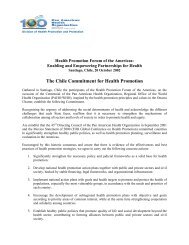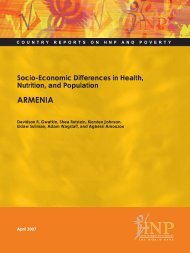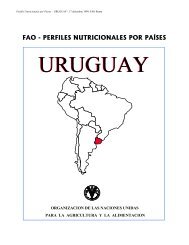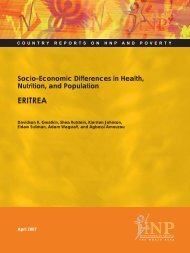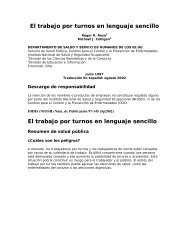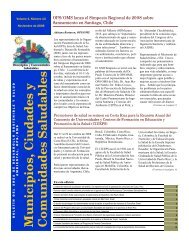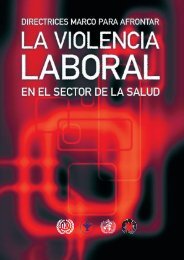Guidelines for drinking-water quality. Volume 1 - BVSDE
Guidelines for drinking-water quality. Volume 1 - BVSDE
Guidelines for drinking-water quality. Volume 1 - BVSDE
Create successful ePaper yourself
Turn your PDF publications into a flip-book with our unique Google optimized e-Paper software.
facilities and expertise as well as the appropriate legislative framework.<br />
The judgement of safety - or what is an acceptable level of risk in particular circumstances - is a<br />
matter in which society as a whole has a role to play. The final judgement as to whether the<br />
benefit resulting from the adoption of any of the guideline values given here as standards justifies<br />
the cost is <strong>for</strong> each country to decide. What must be emphasized is that the guideline values have<br />
a degree of flexibility and enable a judgement to be made regarding the provision of <strong>drinking</strong><strong>water</strong><br />
of acceptable <strong>quality</strong>.<br />
Water is essential to sustain life, and a satisfactory supply must be made available to consumers.<br />
Every ef<strong>for</strong>t should be made to achieve a <strong>drinking</strong>-<strong>water</strong> <strong>quality</strong> as high as practicable. Protection<br />
of <strong>water</strong> supplies from contamination is the first line of defence. Source protection is almost<br />
invariably the best method of ensuring safe <strong>drinking</strong>-<strong>water</strong> and is to be preferred to treating a<br />
contaminated <strong>water</strong> supply to render it suitable <strong>for</strong> consumption. Once a potentially hazardous<br />
situation has been recognized, however, the risk to health, the availability of alternative sources,<br />
and the availability of suitable remedial measures must be considered so that a decision can be<br />
made about the acceptability of the supply.<br />
As far as possible, <strong>water</strong> sources must be protected from contamination by human and animal<br />
waste, which can contain a variety of bacterial, viral, and protozoan pathogens and helminth<br />
parasites. Failure to provide adequate protection and effective treatment will expose the<br />
community to the risk of outbreaks of intestinal and other infectious diseases. Those at greatest<br />
risk of <strong>water</strong>borne disease are infants and young children, people who are debilitated or living<br />
under unsanitary conditions, the sick, and the elderly. For these people, infective doses are<br />
significantly lower than <strong>for</strong> the general adult population.<br />
The potential consequences of microbial contamination are such that its control must always be<br />
of paramount importance and must never be compromised.<br />
The assessment of the risks associated with variations in microbial <strong>quality</strong> is difficult and<br />
controversial because of insufficient epidemiological evidence, the number of factors involved,<br />
and the changing interrelationships between these factors. In general terms, the greatest<br />
microbial risks are associated with ingestion of <strong>water</strong> that is contaminated with human and animal<br />
excreta. Microbial risk can never be entirely eliminated, because the diseases that are<br />
<strong>water</strong>borne may also be transmitted by person-to-person contact, aerosols, and food intake; thus,<br />
a reservoir of cases and carriers is maintained. Provision of a safe <strong>water</strong> supply in these<br />
circumstances will reduce the chances of spread by these other routes. Waterborne outbreaks<br />
are particularly to be avoided because of their capacity to result in the simultaneous infection of a<br />
high proportion of the community.<br />
The health risk due to toxic chemicals in <strong>drinking</strong>-<strong>water</strong> differs from that caused by<br />
microbiological contaminants. There are few chemical constituents of <strong>water</strong> that can lead to acute<br />
health problems except through massive accidental contamination of a supply. Moreover,<br />
experience shows that, in such incidents, the <strong>water</strong> usually becomes undrinkable owing to<br />
unacceptable taste, odour, and appearance.<br />
The fact that chemical contaminants are not normally associated with acute effects places them<br />
in a lower priority category than microbial contaminants, the effects of which are usually acute<br />
and widespread. Indeed, it can be argued that chemical standards <strong>for</strong> <strong>drinking</strong>-<strong>water</strong> are of<br />
secondary consideration in a supply subject to severe bacterial contamination.<br />
The problems associated with chemical constituents of <strong>drinking</strong>-<strong>water</strong> arise primarily from their<br />
ability to cause adverse health effects after prolonged periods of exposure; of particular concern<br />
are contaminants that have cumulative toxic properties, such as heavy metals, and substances<br />
that are carcinogenic.




